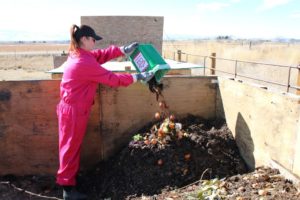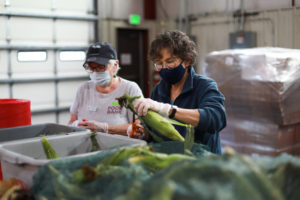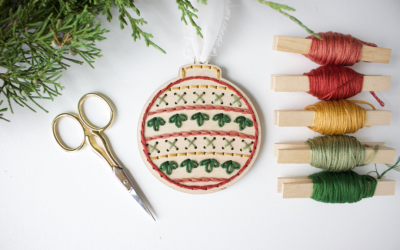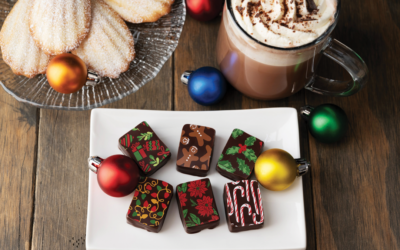Every one of us has been guilty of wasting food. Maybe your eyes are bigger than your stomach at the dinner table or shopping hungry leads to impulse buys at Costco, but the result is almost always the same: perfectly good food ending up in the trash.
Food waste adds up: According to Feeding America, U.S. residents throw away 108 billion pounds of food a year. That equates to nearly 40 percent of all food from grocers to restaurants to our very own kitchens.

Compost Queen offers curbside composting for homeowners in the Fort Collins, Wellington, Laporte and Timnath areas.
Amy Pezzani, CEO of the Food Bank for Larimer County, says food waste usually comes down to over-buying: “At-home waste often has to do with our perceptions around how much food we actually need,” she says. “We walk into a store and buy things we think we’re going to use, and we actually don’t. Some of that ends up being table scraps, but a lot of it is uneaten leftovers or fresh produce that went bad because it was never used.”
It’s expensive, too. The USDA estimates households could save about $370 per person annually just by eliminating food waste at home.
This is where buying in bulk can become a problem, particularly when it comes to perishables. It’s hard to resist a deal but buying five heads of lettuce for the price of two is only really worth it if they actually get eaten within the next week or so.
It’s also hard to keep food from going bad in the fridge if it’s packed so full you can’t see everything inside: out of sight, out of mind. That’s why Pezzani recommends only shopping for several days at a time and being intentional about every item you’re buying, from the value packs to your farmer’s market haul.
Food expiration labels are another main reason food goes to waste, and not just at home, says Reuben Esh, co-owner of Esh’s Market, a Loveland grocer that sells closeout, overstock and straight-from-the-source items at a 40-50 percent discount. In most cases, best by dates and expiration dates do not indicate that a product is no longer safe to consume; they’re usually a conservative measure of the date by which an item will begin to lose freshness.
“Think of dates as a freshness guideline and don’t necessarily avoid items that are approaching their best by date,” he says. “If you are unsure whether something in your fridge or pantry at home is still good, always do a sniff test. I do that regardless of the date because things can be in date and still go bad due to the way they were transported or stored.”
Labels matter more for highly perishable items like meat, which has a greater food safety risk if consumed past expiration. Esh and Pezzani both recommend freezing these products prior to their expiration date to preserve them for later use, just as their suppliers do before transport. Other items can also be frozen, like browning bananas and wilting berries, which make great smoothies.
“Ugly foods,” or produce that is too big, too small, misshapen, scarred or slightly off-color, often stay on supermarket shelves until they can no longer be sold, usually ending up at the Food Bank if they haven’t gone bad. Some of these foods can be bargains.
Since the timeline for organics (produce and animal products) is far shorter than that of canned and dry goods, it’s no surprise that they make up the largest category of food waste and take up nearly a third of landfill space.
“When organics go to the landfill, they are covered and packed down, so they rot instead of decomposing naturally,” says Jamie Blanchard-Poling, owner of local composting service Compost Queen. “If we can deter our organics from the landfill, we can reduce the amount of methane and carbon dioxide releasing into the atmosphere and leaching into our groundwater.”

Volunteers play a key role in reducing food waste by sorting and repackaging large quantities of produce and other items donated to the Food Bank for Larimer County.
Composting is one way to do it, and these days you don’t even need a yard. Companies like Compost Queen have made it easier for anyone to do: simply fill your bucket with compostable food scraps and other eligible items, like cut flowers and leaves, then set it out to be picked up each week.
If you do have the space to compost on your own, make sure to research what items can and can’t be composted (animal products increase the risk of pathogens), as well as how to properly layer, turn, monitor and cure your pile before using it in your landscape.
When composting, Blanchard-Poling says it’s important to be mindful of what goes in your bucket. Any and all parts of fruits and vegetables can be composted, as well as beans, lentils, spent coffee grounds, nuts and shells, beer, moldy bread and tea bags if they’re made with natural fibers. The only real animal product she composts is eggshells because they add a good dose of calcium to the mix, but she’ll also use pet hair and dry kibble because it’s processed to the point of containing little to no meat.
“If you compost things appropriately, you create an entire microbiome of organisms that is incredibly beneficial for your garden or landscape,” she explains. “Not only are you keeping food waste from rotting in the landfill, but you’re also creating a growing environment that suppresses plant disease, promotes higher crop yields and is full of organic fertilizer.”
Gardening with compost-amended soil can help bridge the gap from table to farm before it goes back to farm to table, all while reconnecting us to our food. After all, it’s much easier to throw away store-bought food than it is to toss something you grew yourself, even if you do end up with more cucumbers than you ever thought possible. Eating fruits and veggies from the garden is also more nutritious than buying produce grown in nutrient-poor, over-farmed soil that was harvested weeks or even months ago.
Pezzani says the Food Bank will take all locally grown produce, including excess yield from your garden and fruit trees in your neighborhood. Ripe peaches, pears and apples left on the ground to rot still constitute food waste, and there are always hungry people who will eat what you have to give. Anyone can donate to the food bank, and most grocery stores already do, but there are still plenty of in-demand items that may be sitting in your garden, fridge or pantry.

Some donated items, like these carrots, may look a little too bizarre for the grocery store, but are good to eat and can be distributed by the Food Bank. Photos by Food Bank for Larimer County/Franz Quiñones.
Pezzani also notes that reducing food waste can have a ripple effect throughout the entire process of providing that food. When food is wasted, so is the land, water, labor and energy used in producing, transporting, processing, storing and disposing of it. In other words, if we as a society become less wasteful, all of those resources can be conserved and used more sustainably.
“We’re moving in the right direction with how we think about our buying habits and what happens to our food when we’re done with it,” she says. “Food donations and composting are great first steps, but we need the infrastructure in place for post-consumer food scraps and an outlet for that compost on a larger scale to make a big change. It’s exciting to watch those ideas emerge, and I’m hopeful that we’ll get there soon.”
For more information about Compost Queen, got to compostqueenfc.com.







